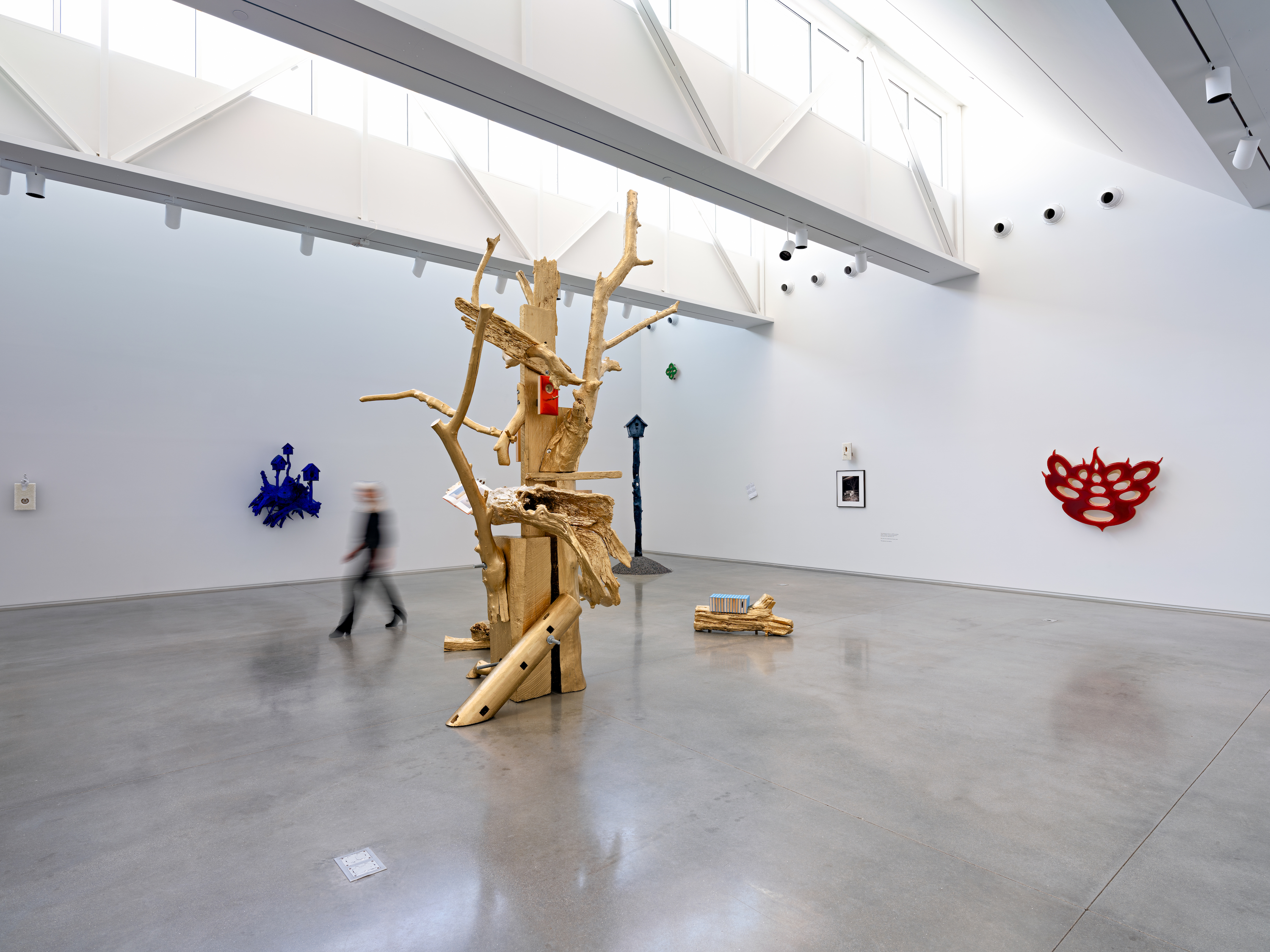“Nature Cult, Seeded | Donald Moffett” as Center for Maine Contemporary Art in Rockland. Photos by Dave Clough Photography The Center for Maine Contemporary Art in Rockland is presenting two views of important contemporary issues – species extinction and Black identity – by two artists: “Nature Cult, Seeded | Donald Moffett” and “To Whom Keeps a Record | Arnold J. Kemp,” both through Sept.
8. WHAT: “Nature Cult, Seeded | Donald Moffett” and “To Whom Keeps a Record | Arnold J. Kemp” WHERE: Center for Maine Contemporary Art, 21 Winter St.

, Rockland WHEN: Through Sept. 8 HOURS: 10 a.m.
to 5 p.m. Monday through Saturday, noon to 5 p.
m. Sunday ADMISSION: $10, $8 senior and students, free for Rockland residents, members and children under 18 INFO: 207-701-5005, cmcanow.org Donald Moffett wants to unsettle you, perhaps even shock you into action.
That is, after all, what he’s done for years as an activist artist. Ergo the title of “Nature Cult.” In an interview with Domus magazine, he told Toshiko Mori (the CMCA’s architect) “I want a word after ‘nature’ that perturbs in a way.
” “Cult” is certainly calculated to elicit this discomfort. The big questions for me are: How impactfully does this exhibit perturb us and spur us to outrage, or to actually do something about the issue at hand? And when do polemics generate the opposite, almost somnambulant response? The single-most haunting gesture of this show is not visual. It is an audio recording that plays in the gallery, explained on a wall text this way: The birdsong you hear is a 1976 recording made in Hawai’i, of the last living bird of the species: the male Kaua’i ō’ō.
His call is for a mate that will never come. The species is now extinct. Let’s forget the dramatic cadence of the words.
This bygone sound is breathtakingly tragic, the realization of its truth triggering mourning, grief, rage and fear all at once. This establishes a premise of absence that supports the many birdhouse sculptures in the exhibit, their hole openings suddenly becoming symbols of something ominous and melancholy. Donald Moffett, “Lot 031024 (call and response),” 2024, 14 3/4 x 8 3/4 x 8 1/4 inches Moffett’s white paintings – made by extruding oil paint onto linen so it looks almost like a shag rug – are elegant messengers of these emotions.
The holes in some of them display a uvula, the fleshy extension that hangs at the back of the throat, which, in the context of this exhibition, comes across as a silent scream. Moffett has used this texture before, but here he adds a new element: plaster casts of his crew’s hands. I willingly surrendered to these, admiring how their positions – a hooked finger, an open hand – evoked a supposedly friendly invitation of a perch, yet also said something about how a welcoming gesture can be the enticement that kills.
At whose hands, after all, did the Kaua’i ō’ō become extinct? One painting with crossed fingers called to mind a gesture common to images of Christ, which, for me at least, was a reading that implied the dangerous presumption of humans playing God over nature. In a subsequent conversation with Moffett, I discovered this wasn’t his intention, which had more to do with a gesture of “cross your fingers and let’s hope.” I prefer my reading, frankly, as it represents more implication and complicity, making me uncomfortable about counting myself as part of a species that thinks more of itself than it should, and wreaks such devastating consequences.
Donald Moffett, “Lot 082019 (cocoa brain),” 2019, Signed, titled, and dated in graphite (verso): D. Moffett Lot 082019 (cocoa brain) 2019, pigmented epoxy resin on wood panel support, steel 96 x 84 x 6 1/2 inches Then things get a bit preachy. I did like the painting “Lot 082019 (cocoa brain),” which is a cross-section of brain painted in slick brown epoxy resin, a brain coral suspended in front of it on a small shelf.
It’s not exactly subtle in its suggestion that we may be looking at the effluent-filled cerebrum of a climate-change denier who insists on ignorance, even in the presence of a bleached specimen of coral that corroborates this depressing phenomenon. It is formally elegant in execution and also allows me to feel gleefully self-righteous. There’s an elegance to two cast-bronze bird houses, too; one white, one black.
They have a solemnity to them – derived from their classical art-making process and their sober palette – that articulates the issue of endangered species with stillness, silence and quiet urgency. I would even admit that the multiple birdhouses on driftwood that Moffett painted Yves Klein blue are moving. It’s when we get to a chartreuse birdhouse protruding from a pecan-filled tire, a sign reading “Vacancy” shoved into a watering can before it, that I actually winced.
Another view of “Nature Cult, Seeded | Donald Moffett” at CMCA. Unfortunately, this is the sculpture that greets most visitors (I happened to enter from the other side). The absence of extinction is already so affectingly established that this sculpture feels facile, even schmaltzy.
Every movement needs a radical fringe, as Moffett’s own involvement with ACT UP can attest. The color and message here are loud and in your face. Pushing the envelope is one thing.
Being brow-beaten (especially by the unnecessarily obvious admonition of the vacancy sign) is another. The central monumental piece, “Lot 030323 (the golden bough),” also feels overcooked. Had Moffett simply painted this felled tree gold to suggest its preciousness and let it dominate the space as a silent presence in the gallery, it might have felt like an object of respect and veneration, or said something persuasive about how the destruction of species habitats is a kind of violent, disrespectful blasphemy.
Instead, the inclusion of what look like light switch plates sporting the uvula scream mentioned above, the volume of “An American Bestiary” and the collection of Jeff Goodell’s “The Water Will Come: Rising Seas, Sinking Cities and the Remaking of the Civilized World,” which Moffett crammed into a golden log, well, “less is more” might have been an admonition to remember. Despite their exquisite execution, the epoxy resin paintings can at times feel slick and flashy. “Lot 081718 (nature cult, the root remembers),” for example, called to mind flaming hot rod logos rather than the titular root’s valuable historical record.
I also worried about the material’s toxicity. Epoxy can contain CMR substances that can cause cancer, change DNA or mess with reproductive systems. New resins exist that remove these substances.
One hopes Moffett is using the latter. SELF-MADE MAN One of the most compelling works in “To Whom Keeps a Record” is “Stage,” a series of approximately 5-foot tall wood letters stacked against a wall that spell – were we to pull them apart and lay them out as sentences – “I WOULD SURVIVE. I COULD SURVIVE.
I SHOULD SURVIVE.” It is a testament to resilience, though not a new theme for either Black or gay culture, both of which Kemp is a part. What makes it powerful, to my mind, is that the message is hidden to the viewer who might not read the wall label.
“To Whom Keeps a Record | Arnold J. Kemp” at Center for Maine Contemporary Art. In its simultaneous openness and concealment, it feels like an embodiment of an innate strength and defiance that undergirds both the Black and gay experiences, no matter what is visible on the surface.
It is an accumulation of cultural messages, as are the other works in the show, representing all that preceded and that informs those experiences. Since the components of Kemp’s works are drawn mostly from his personal archives, the show is also incredibly personal, offering glimpses into the processes by which Kemp constructs and actualizes an image of self, as well as of self as artist. Literary works that informed that self appear in “Possible Biography,” Kemp’s installation of photographs in which his hands hold up works that were influential to this enterprise.
These include books by James Baldwin, Toni Morrison, Wanda Coleman, Cornel West, Glen Ligon and others. “Music Brings Goodness to Us All Unless One Has Some Other Motive for Its Use” is more interactive. It’s basically a record player with speakers and a box of old vinyl recordings next to it, and viewers are invited to play anything from the selection as well as add their own records to the box.
These include not only music (jazz greats such as Ornette Coleman and Sun Ra are not a surprise here), but also recordings of important scholars, historians, theorists and political figures – from Langston Hughes and Malcolm X to Sidney Poitier. In this piece, the connection between a history of self and the actual self who “curates” a unique image from that history is palpable. It also sheds light on the sheer quantity of images, words, experiences, preferences and other realities that we all sift through to find a sense of ourselves among them.
Jorge S. Arango has written about art, design and architecture for over 35 years. He lives in Portland.
He can be reached at: [email protected] Modify your screen name Please sign into your Press Herald account to participate in conversations below. If you do not have an account, you can register or subscribe .
Questions? Please see our FAQs . Your commenting screen name has been updated. Send questions/comments to the editors.
« Previous.



















